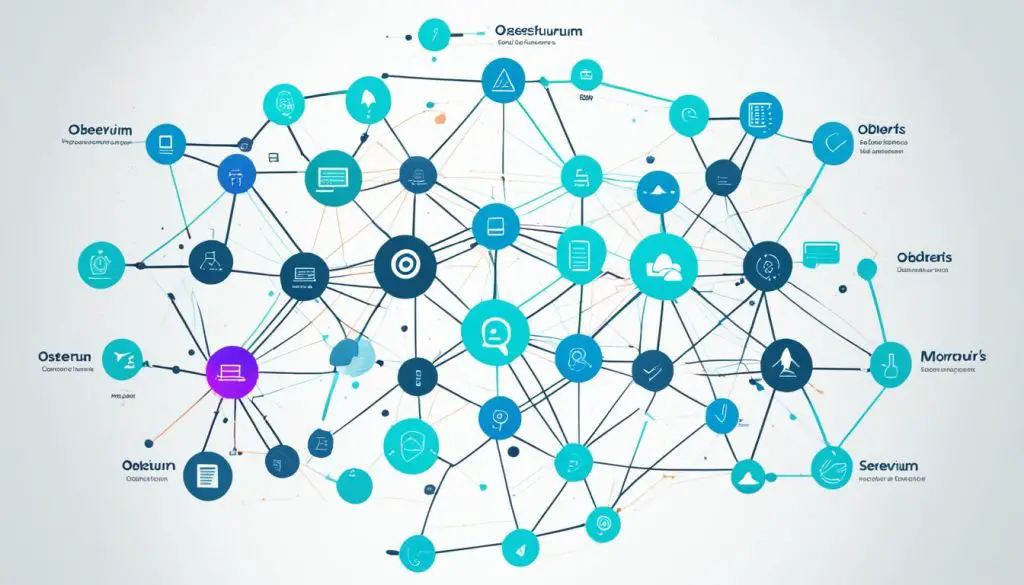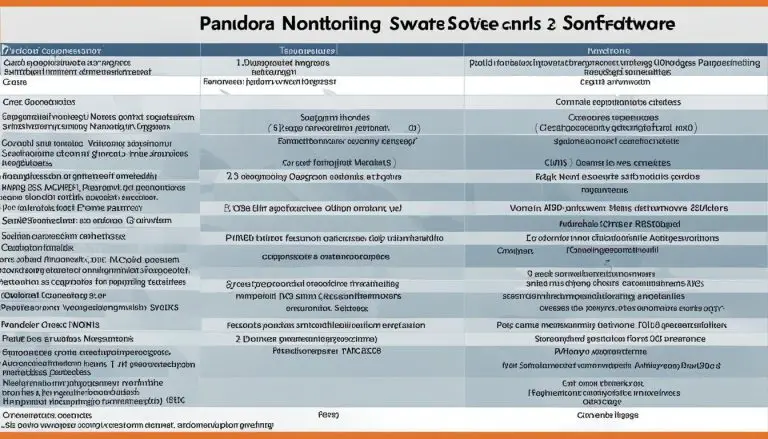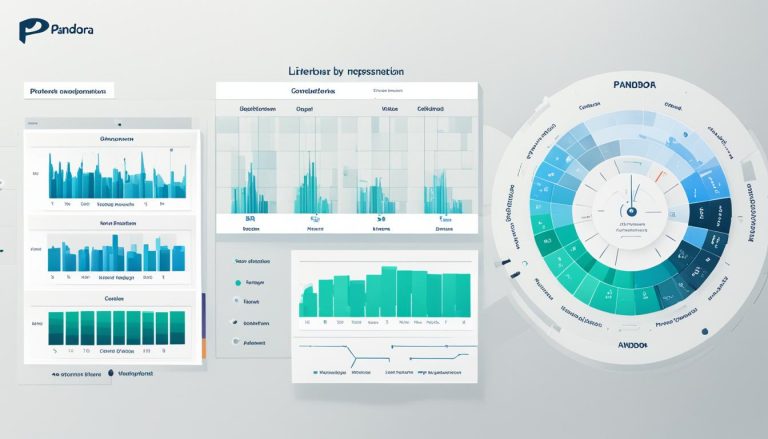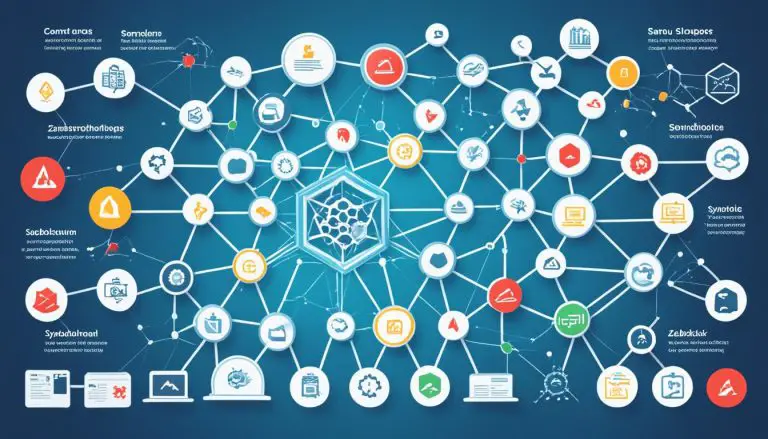Observium vs. Cacti: Network Monitoring Face-Off
When it comes to network monitoring, choosing the right tool can make all the difference in optimizing your network performance and effectively managing your infrastructure. Two popular options that often come into consideration are Observium and Cacti.
But which of these network monitoring tools is the best fit for your organization? Are they just interchangeable options, or do they offer unique features and benefits that set them apart?
In this comprehensive comparison, we will dive into the performance, features, and benefits of both Observium and Cacti. By the end, you’ll have the insights you need to make an informed decision and find the best network monitoring tool for your specific needs.
Key Takeaways:
- Observium and Cacti are popular network monitoring tools to consider for your organization.
- Network monitoring plays a crucial role in optimizing performance and detecting issues.
- The checklist for choosing the perfect network monitoring tool includes scalability, integration capabilities, and reporting features.
- Observium offers comprehensive reporting, SNMP monitoring, and device autodiscovery.
- Cacti specializes in graphing network data and customizable templates.
Why Network Monitoring is Important for Your Organization
Network monitoring is a critical component of effective network management and plays a vital role in ensuring the smooth and efficient operation of your organization’s network. By implementing a reliable network monitoring tool, you can proactively monitor and manage your network, improving its performance, preventing potential issues, and detecting malicious traffic.
One of the key advantages of network monitoring is the ability to improve network performance. By continuously monitoring your network, you can identify bottlenecks, bandwidth constraints, and other performance issues. This enables you to take proactive measures to optimize your network infrastructure and ensure optimal performance for your users.
“Implementing a robust network monitoring strategy allows you to prevent network issues before they impact your business operations.”
Network monitoring also helps prevent network downtime and enables you to address issues before they escalate. By monitoring network traffic, diagnostics, and device status, you can detect early warning signs and take proactive steps to resolve potential problems. This ensures that your organization’s network remains up and running, minimizing disruptions and ensuring business continuity.
In addition to performance optimization and issue prevention, network monitoring tools allow you to detect and mitigate security threats. These tools analyze network traffic in real time, enabling you to identify potential malicious activity or unusual behavior. By detecting and responding to security threats promptly, you can protect your network infrastructure and sensitive data from unauthorized access or data breaches.
Analyzing network performance is another key advantage of network monitoring. By monitoring various performance metrics, such as bandwidth usage, latency, and packet loss, you can gain valuable insights into your network’s health and performance. These insights enable you to make data-driven decisions, identify areas of improvement, and optimize your network for better overall performance.
Overall, network monitoring is an essential practice for any organization that relies on a robust and reliable network infrastructure. It allows you to proactively manage your network, identify and troubleshoot potential issues, prevent downtime, detect security threats, and optimize performance. By investing in a reputable network monitoring tool, you can ensure the smooth and efficient operation of your organization’s network, providing a solid foundation for your business activities.
Key Benefits of Network Monitoring:
- Improved network performance
- Prevention of network issues
- Detection of malicious traffic
- Real-time analysis of network performance
- Proactive network management and troubleshooting
- Enhanced security and threat detection
Checklist for Choosing the Perfect Network Monitoring Tool
When selecting a network monitoring tool, it is crucial to consider various factors that align with your organization’s specific requirements. Evaluating the monitoring software based on scalability, integration capabilities, licensing system, configuration management, remote monitoring, virtualized systems, reporting capabilities, and alert management will help you make an informed decision for your network management strategy.
Consider the following checklist:
- Scalability: Ensure that the tool can handle the growing demands of your network infrastructure and accommodate future expansion.
- Integration Capabilities: Assess whether the tool can seamlessly integrate with your existing systems and third-party applications to provide a unified monitoring solution.
- Licensing System: Understand the licensing model of the software to determine its suitability for your organization’s budget and licensing requirements.
- Configuration Management: Look for features that simplify the configuration and management of network devices, such as automated device discovery and centralized management.
- Remote Monitoring: Check if the tool supports remote monitoring functionality, allowing you to monitor network performance and troubleshoot issues from anywhere.
- Virtualized Systems: If you have virtualized environments, verify if the tool offers dedicated monitoring features for virtualized systems, such as integration with hypervisors and virtual machine monitoring.
- Reporting Capabilities: Assess the tool’s reporting capabilities to ensure it provides comprehensive and customizable reports that meet your organization’s needs.
- Alert Management: Look for robust alerting features that allow for proactive monitoring and quick response to network issues, such as customizable alert thresholds and notification methods.
By thoroughly evaluating network monitoring tools based on the checklist above, you can choose the perfect solution that aligns with your organization’s unique network management requirements and empowers you to maintain optimal network performance and security.
Observium Overview
Observium is a powerful network monitoring software that provides comprehensive insights into the performance and availability of your network. With Observium, you can effectively monitor and manage your network to ensure its optimal operation and performance.
One of the key features of Observium is its SNMP (Simple Network Management Protocol) monitoring capability. SNMP allows Observium to collect data from various network devices, enabling you to gain real-time visibility into your network’s health and performance. This feature ensures that you can proactively identify and address any potential issues before they impact your network.
Another advantage of Observium is its scalability. It is designed to handle large-scale deployments, making it suitable for organizations with complex network infrastructures. Whether you have a small network or a vast enterprise infrastructure, Observium can accommodate your monitoring needs and provide you with the necessary insights to ensure smooth network operations.
In addition to SNMP monitoring and scalability, Observium offers comprehensive reporting capabilities. The software provides detailed reports and analytics on various network performance metrics, allowing you to analyze trends, identify bottlenecks, and make data-driven decisions to optimize your network performance.
Observium’s device discovery feature simplifies the management of your network devices. It automatically identifies and adds devices to the monitoring system, saving you time and effort in manually adding each device. This automated process ensures that no device is left unmonitored, allowing you to have a complete overview of your network.
The graphing and visualization capabilities of Observium make it easier to interpret complex network data. It provides clear and intuitive graphs that allow you to visualize the performance of your network devices, interfaces, and services. This visualization enables you to quickly identify patterns, anomalies, and potential issues, facilitating efficient troubleshooting and network optimization.
To summarize, Observium is a feature-rich network monitoring software that offers SNMP monitoring, scalable monitoring, comprehensive reporting, device discovery, and graphing and visualization capabilities. It provides a robust and intuitive interface for monitoring network performance and troubleshooting network issues.
Cacti Overview
I am excited to introduce you to Cacti, a leading network monitoring tool that specializes in graphing and visualizing network data. With its robust performance analysis capabilities and support for various polling mechanisms, including SNMP (Simple Network Management Protocol), Cacti is a popular choice for monitoring and analyzing network performance.
One of the standout features of Cacti is its ability to graph network data, providing in-depth insights into your network’s performance. The customizable templates in Cacti allow you to tailor the graphing and visualization to suit your specific needs, making it easier to identify patterns, trends, and potential issues.
Cacti’s performance analysis tools enable you to analyze network data and identify bottlenecks or areas that require optimization. By monitoring key performance metrics, you can proactively address any inefficiencies and ensure smooth network operations.
SNMP support is a crucial aspect of any network monitoring tool, and Cacti provides seamless integration with SNMP-enabled devices. This enables you to collect comprehensive network data and gain a holistic view of your infrastructure.
In addition to its robust feature set, Cacti offers an intuitive user interface that makes it easy to navigate and configure. Whether you are a seasoned IT professional or someone new to network monitoring, Cacti’s user-friendly interface ensures a smooth experience.
With its customizable templates, graphing capabilities, performance analysis tools, and SNMP support, Cacti is a powerful tool for monitoring and managing your network. It empowers you to make data-driven decisions, optimize performance, and ensure the smooth operation of your network infrastructure.
Performance Comparison: Observium vs. Cacti
Both Observium and Cacti offer reliable monitoring capabilities, making them popular choices among network administrators. However, they each have their own strengths and features that set them apart.
Observium: Scalability and Comprehensive Reporting
Observium excels in scalability, allowing it to handle large-scale network deployments with ease. It is capable of monitoring a wide range of devices, making it suitable for organizations with diverse network infrastructure.
Moreover, Observium offers comprehensive reporting features that provide detailed insights into network performance and trends. With customizable dashboards, users can visualize data and gain actionable insights to optimize their network management strategy.
Cacti: Graphing and Data Visualization
Cacti is renowned for its powerful graphing capabilities, which allow users to visualize network data and trends effectively. With customizable templates, users can create visually appealing graphs that suit their specific monitoring needs.
As a monitoring tool, Cacti excels in data visualization, making it easier for network administrators to identify anomalies and performance issues quickly.
When deciding between Observium and Cacti, it’s important to consider your specific monitoring requirements. If scalability and comprehensive reporting are your top priorities, Observium may be the ideal choice. On the other hand, if you prioritize robust graphing and data visualization capabilities, Cacti would be an excellent option. Both tools have their own unique offerings, so it ultimately depends on your organization’s needs and preferences.
Key Features of Observium
Observium, a robust network monitoring software, offers a wide range of key features designed to enhance your network management strategy. With Observium, you can easily monitor and manage your network’s performance, thanks to its advanced capabilities and intuitive interface.
One of the standout features of Observium is its SNMP (Simple Network Management Protocol) monitoring functionality. This allows you to comprehensively monitor your network by collecting valuable data from your devices, such as routers, switches, and servers. SNMP monitoring enables you to gather crucial performance metrics and gain real-time insights into the health of your network.
Observium also simplifies device management through its device autodiscovery feature. This feature automatically detects and adds new devices to your network, saving you valuable time and effort. It ensures that your network inventory remains up-to-date, allowing you to effectively monitor and manage your entire network infrastructure.
Furthermore, Observium provides you with powerful network graphing capabilities. With its graphing and visualization features, you can easily analyze network performance trends, identify bottlenecks, and make informed decisions to optimize your network’s efficiency. These visual representations enhance your understanding of your network’s behavior and aid in troubleshooting network-related issues.
An added advantage of Observium is its support for a wide array of devices. Whether you have a mixed environment comprising different brands and models or a specialized network setup, Observium is designed to handle it all. Its device compatibility ensures that you can effectively monitor and manage your entire network infrastructure from a single platform.
Observium also caters to the need for customization with its customizable dashboards. You can tailor the interface to display the most important information for your specific network management needs. This flexibility empowers you to create personalized views and prioritize critical metrics, offering a tailored monitoring experience.
Observium’s feature-rich platform, encompassing SNMP monitoring, device autodiscovery, network graphing, support for various devices, and customizable dashboards, makes it a top choice for organizations seeking comprehensive network monitoring solutions.
For a visual representation of Observium’s capabilities, take a look at the network graphing example below:

Key Features of Cacti
When it comes to network monitoring, Cacti offers a range of impressive features that make it a popular choice for organizations. Let’s take a closer look at some of its key capabilities:
Network Data Graphing
Cacti excels in graphing and visualizing network data, providing you with clear and detailed visual representations of your network’s performance. This feature allows you to easily identify trends, track changes, and make informed decisions to optimize your network’s efficiency.
Customizable Templates
To meet your specific monitoring needs, Cacti offers customizable templates that let you design and personalize your monitoring dashboards. This flexibility allows you to focus on the metrics that matter most to your organization, enhancing your ability to monitor and analyze network performance effectively.
Polling Mechanisms
With support for various polling mechanisms, including SNMP (Simple Network Management Protocol), Cacti enables you to collect data from a wide array of devices and services. This ensures comprehensive and accurate monitoring of your network’s health and performance.
SNMP Support
Cacti’s built-in SNMP support allows you to monitor SNMP-enabled devices, such as routers, switches, and servers, effectively. By leveraging SNMP capabilities, you can gather valuable performance data and gain insights into your network infrastructure.
Performance Analysis
Cacti provides powerful performance analysis tools that help you identify and troubleshoot network issues quickly. These tools enable you to track key performance metrics, visualize trends, and pinpoint areas where improvements can be made, ensuring optimal network performance.
With its focus on network data graphing, customizable templates, polling mechanisms, SNMP support, and performance analysis, Cacti offers a comprehensive set of features to meet your network monitoring needs.
Pros and Cons of Observium
When considering network monitoring tools, it’s essential to evaluate the pros and cons of each option to make an informed decision. Observium offers several benefits and advantages, along with some limitations that may be relevant to your specific network monitoring requirements.
Observium Benefits:
- Comprehensive Monitoring Capabilities: Observium provides a robust suite of features that allow you to monitor and manage your network effectively. From SNMP monitoring to device autodiscovery, it offers extensive coverage for comprehensive network monitoring.
- Support for SNMP Monitoring: SNMP (Simple Network Management Protocol) is widely used in network monitoring, and Observium offers strong support for SNMP monitoring. This ensures that you can gather crucial performance data from your network devices.
- Customizable Dashboards: Observium allows you to personalize your monitoring experience by customizing dashboards according to your specific needs. This flexibility enhances usability and provides a user-friendly interface for monitoring your network.
Limitations of Observium:
- Steeper Learning Curve: Observium’s rich set of features may result in a steeper learning curve for beginners or those unfamiliar with network monitoring. However, once mastered, it offers powerful capabilities for managing your network effectively.
- Limited Graphing Capabilities: While Observium provides graphing and visualization capabilities, it may not be as extensive as some other network monitoring tools. If detailed graphing is a critical requirement for your network monitoring, you may want to consider alternative options.
When comparing Observium to other network monitoring tools, it’s important to take into account these pros and cons. Assessing your specific needs and priorities will help you determine if Observium aligns with your network management strategy.
Observium offers comprehensive monitoring capabilities, strong support for SNMP monitoring, and customizable dashboards. However, it may have a steeper learning curve for beginners and may not provide as extensive graphing capabilities as some other tools.
Now that we’ve explored the pros and cons of Observium, let’s move on to a comprehensive comparison between Observium and Cacti, two popular network monitoring tools.
Pros and Cons of Cacti
In the realm of network monitoring tools, Cacti offers several distinct advantages that make it a popular choice for organizations. It boasts robust graphing capabilities, allowing users to visualize network data effectively. The customizable templates offered by Cacti ensure flexibility and ease of customization, catering to unique monitoring needs. Additionally, Cacti supports various polling mechanisms, including SNMP, providing users with the freedom to choose the most suitable option for their network requirements.
However, it is important to consider the limitations of Cacti as well. While it excels in graphing and visualization, it may lack some advanced monitoring features present in other tools. Additionally, Cacti may require more manual configuration compared to its counterparts, potentially requiring additional time and effort from the user. These factors should be taken into account when evaluating Cacti in comparison to other network monitoring options.
When conducting a network monitoring tool comparison, such as the Observium vs. Cacti face-off, it is vital to consider the benefits, advantages, and limitations of each tool. By weighing these factors, you can make an informed decision that aligns with your organization’s network management strategy.
Conclusion
When it comes to choosing the best network monitoring tool for your organization’s network management strategy, it’s essential to evaluate the strengths and weaknesses of both Observium and Cacti. Observium excels in scalability and comprehensive reporting, making it an excellent choice for larger networks that require in-depth performance analysis and monitoring. On the other hand, Cacti stands out for its graphing and visualization features, which are ideal for organizations that prioritize data visualization and graphical representations.
To make an informed decision, consider your specific network monitoring needs and preferences. Assess the pros and cons of each tool, keeping in mind factors such as performance, scalability, ease of use, and reporting capabilities. By thoroughly evaluating these aspects, you can choose the network monitoring tool that best aligns with your organization’s requirements and maximizes your network’s efficiency.
Ultimately, your choice between Observium and Cacti will depend on your unique network management strategy. Whether you prioritize comprehensive reporting or advanced graphing capabilities, both tools offer reliable monitoring functionalities to help you optimize your network’s performance. By carefully considering your organization’s needs and conducting a thorough Observium vs. Cacti comparison, you can confidently select the best network monitoring tool that empowers your network management efforts.
FAQ
What is Observium?
What is Cacti?
What are the key features of Observium?
What are the key features of Cacti?
How does Observium perform compared to Cacti?
What are the benefits of using Observium?
What are the benefits of using Cacti?
Source Links
- https://pandorafms.com/blog/network-monitoring-tools/
- https://thectoclub.com/tools/best-network-monitoring-software/
- https://24x7servermonitoring.com/top-5-free-network-monitoring-tools/
- About the Author
- Latest Posts
Mark is a senior content editor at Text-Center.com and has more than 20 years of experience with linux and windows operating systems. He also writes for Biteno.com





